
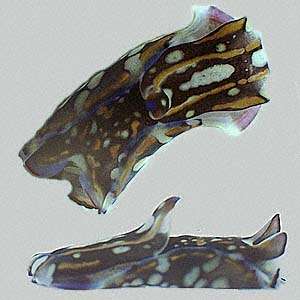
Philinopsis cyanea
(Martens, 1879)
Order: CEPHALASPIDEA
Family: Aglajidae
DISTRIBUTION
Tropical Indo-West Pacific.
PHOTO
UPPER: Two adult animals, Zanzibar, Tanzania. (Up to 70mm long alive). July, 1971.
LOWER: Juvenile animal, Kunduchi Beach, Dar es Salaam, Tanzania. 15mm long alive. May 1974
PHOTOS: Bill Rudman.
Note added 4 Feb 2006: Philinopsis cyanea is almost certainly a synonym of the earlier Philinopsis speciosa Pease, 1860. See that Fact Sheet for a fuller discussion.
Philinopsis cyanea, is quite a variable species found throughout the tropical Indo-West Pacific. It varies in colour from plain black to black with blue, white, yellow or brownish-yellow markings. Sometimes animals have a pale brown background colour. Juvenile animals are often more colourful than adults. In my picture alongside, of a juvenile animal from Dar es Salaam, Tanzania (May, 1974), you can see the characteristic shape of species of Philinopsis. The posterior edge of the headshield has a tapering crest, which stands erect, and the body is cylindrical in shape. Species of Philinopsis are usually found burrowing through sand or mud. They have lost their radular teeth.
There are two quite distinct groups in the genus, one with a large eversible buccal bulb like Philinopsis cyanea, and a second with a long tubular pharynx like Philinopsis gardineri. The group with the large buccal bulb feed on other bubble shells, such as Bulla, Atys and Haminoea.
They feed by partially everting their large muscular buccal bulb, (or pharynx), to envelop their prey which they swallow whole. After digestion, the empty, unbroken shell of the prey is regurgitated, being too large to pass through the gut. Species of Philinopsis, when collected, often spit out two or three clean, unbroken bubble shells.
I remember once in Zanzibar collecting some animals from sea grass beds where the bubble shell Bulla ampulla was also abundant. The Philinopsis ranged in length from 30-70mm and within 2 to 3 hours all had regurgitated 3 to 5 Bulla shells ranging in length from 5-15mm. They clearly have quite an impact on the ecology of their neighbourhood.
References:
• Rudman,W.B., 1972. A comparative study of the genus Philinopsis Pease, 1860 (Aglajidae, Opisthobranchia). Pacific Science, 26: 381-399.
• Rudman,W.B., 1972. Structure and functioning of the gut in the Bullomorpha (Opisthobranchia). Journal of Natural History, 6: 547-560.
Rudman, W.B., 1998 (July 27) Philinopsis cyanea (Martens, 1879). [In] Sea Slug Forum. Australian Museum, Sydney. Available from http://www.seaslugforum.net/find/philcyan
Related messages
What is Philinopsis cyanea doing?
August 6, 2008
From: Valda Fraser

Dear Bill
I found a pool on a wide beach that had been caused by high seas. Unfortunately the pool was in the process of drying out. On the edges of the water, Philinopsis cyanea (maybe a dozen of them) were creating these sacs - perhaps to lay eggs in before they died. What do you think?
Locality: Pomene, 20 cm, Mozambique, Indian, 15 February 2008, Pool on beach. Length: 70 mm. Photographer: Valda Fraser.
Best wishes
Valda
valdafraser@mweb.co.za
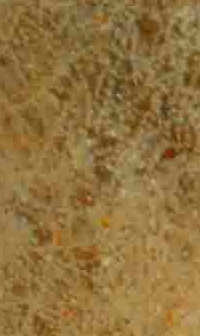
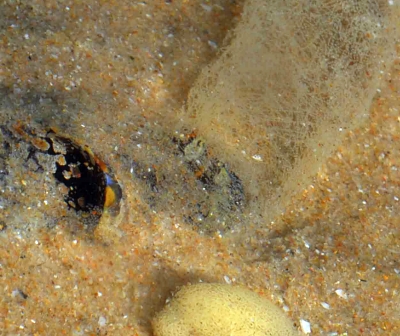
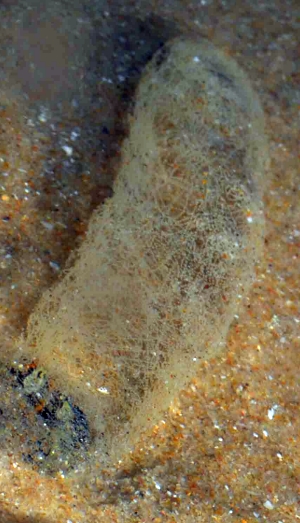
Dear Valda,
If you look at the close-ups I have included, you will see that the sacs are in fact filled with strings of small white eggs. Aglajids have this strange way of putting their eggs in the egg sac by wrapping the egg string around their head and then gradually 'pushing' the string and the egg sac enclosing it off the front of the head. Your photo illustrates the process rather well.
I am not quite sure of your description of the pool the aglajids are in. Do you mean it is above the usual high tide level and so when it dries out that is the end for Philinopsis, or is it likely to fill up again at the next high tide? In either case, it is interesting how many sea slugs start egg laying when they are in dire straits. Often when you collect them they will lay eggs in dishes, bottles etc, almost as though they know their end is near and this is their last chance to pass on their genes. Interestingly often the 'egg string' contains no eggs, sometimes just a ribbon of yolk, and sometimes the eggs are unfertilised. These 'mistakes' would suggest to me that going through the motions of egg-laying is an innate response to stress. Certainly it is not a bad response, because if the animals do have fertilised eggs it is better to have them out than in, and if the animal is about to die it really doesn't matter about the 'mistakes'.
Best wishes,
Bill Rudman
Dark colour form of Philinopsis cyanea
August 5, 2008
From: Hugues Flodrops
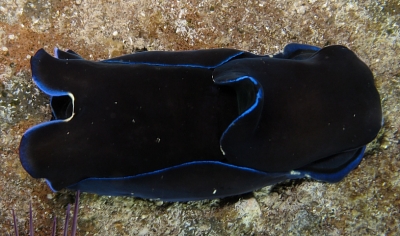
Concerning message #21233:
Dear Bill
Thanks for your explanation about the blue marking we usually see in Philinopsis cyanea. Here is an example of an extreme colour range for the same species. A dark colour like we can see on Philinopsis gardineri, but gardineri has a high rounded bump on the head.
Locality: Etang-Salé, 1,5 metre, Reunion Island, Indian Ocean, 28 November 2007, Night. Length: 30 mm. Photographer: Hugues Flodrops.
Best regards,
Hugues Flodrops.
hugues.flodrops@wanadoo.fr
Flodrops, H., 2008 (Aug 5) Dark colour form of Philinopsis cyanea. [Message in] Sea Slug Forum. Australian Museum, Sydney. Available from http://www.seaslugforum.net/find/21397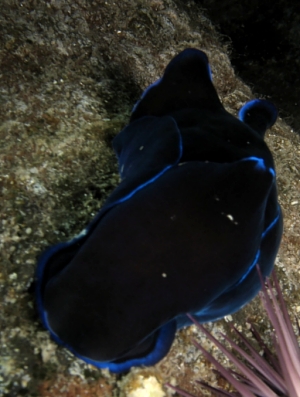
Thanks Hugues,
Yes, as I have mentioned before [message #18703] the 'bump' on the head distinguishes P. gardineri from both P. cyanea and Chelidonura varians.
Best wishes,
Bill Rudman
Philinopsis cyanea from Reunion Island
February 18, 2008
From: Hugues Flodrops
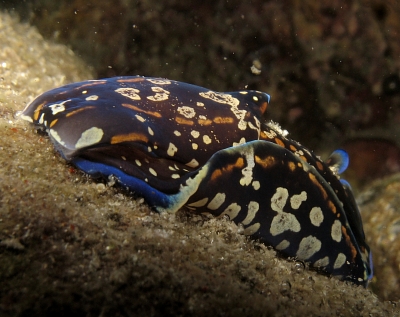
Dear Bill,
On the same night [see message #21233], about three meters away, I found a second Philinopsis which looked like P. cyanea. The classical yellow lines on the head are modified.
Locality: Etang-Salé, 1 metre, Reunion Island, Indian Ocean, 27 November 2007, Night. Length: 60 mm. Photographer: Hugues Flodrops.
I hope that you can explain these variations.
Bests regards.
Hugues
hugues.flodrops@wanadoo.fr
Flodrops,H., 2008 (Feb 18) Philinopsis cyanea from Reunion Island. [Message in] Sea Slug Forum. Australian Museum, Sydney. Available from http://www.seaslugforum.net/find/21234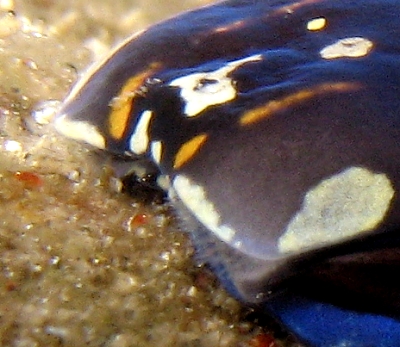
Dear Hugues,
Both this animal and the one in your earlier message are colour forms of the same species. I have included a close-up of the head to show the sensory bristles which are found on pads on each side of the mouth. Although they are usually not as obvious as in some species of Chelidonura, sensory bristles are characteristic of all species of the family Aglajidae
Best wishes,
Bill Rudman
Philinopsis taronga? from Reunion Island
February 18, 2008
From: Hugues Flodrops
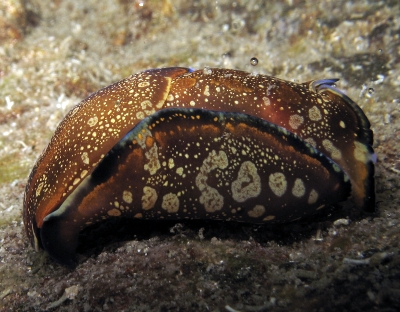
Dear Bill,
Yesterday I found two specimens of Philinopsis. First, I thought there are two variant of Philinopsis cyanea but now, my guest is that this one is Philinopsis taronga. It's looks like your picture of Shelly Beach [message #9906].
Locality: Etang-Salé, 1 metre, Reunion Island, Indian Ocean, 27 November 2007, Night. Length: 45-50 mm. Photographer: Hugues Flodrops.
A second message with Philinopsis cyanea follows [#21234 ].
Thanks for your thoughts.
Regards.
Hugues
hugues.flodrops@wanadoo.fr
Flodrops,H., 2008 (Feb 18) Philinopsis taronga? from Reunion Island. [Message in] Sea Slug Forum. Australian Museum, Sydney. Available from http://www.seaslugforum.net/find/21233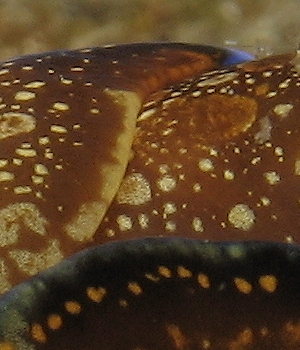
Dear Hugues,
Althought they have colour similarities, P. taronga seems to be endemic to south eastern Australia and New Zealand. I have seen animals like your colour form freely mixing and mating with more 'typical' P. cyanea in Zanzibar, so I have no doubt that is what it is. Also P. taronga never has the blue markings we usually see in P. cyanea.
When I get a moment I must be brave and accept that P. cyanea and P. speciosa are the same species [see Fact Sheet] and as P. speciosa is older it will have priority over P. cyanea.
Best wishes,
Bill Rudman
Philinopsis cyanea from Perth
January 17, 2007
From: Brent Murdoch
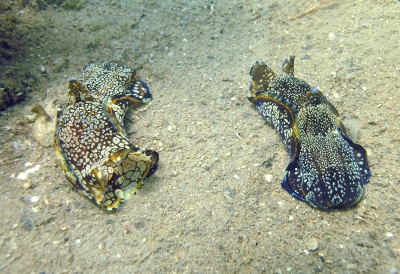
Hi Bill,
I was hoping that you could identify the attached. I have never seen them before. I watched 2 of them come out from under the sand.
They are in 4.5 m of 23°C water close to Fremantle, Perth, Western Australia.
I seen many types over a two day period, many of which are described a rare in the Fred Wells and Clayton Bryce book from the WA musem.
Regards
Brent Murdoch
bmurdoch@whimcreek.straits.com.au
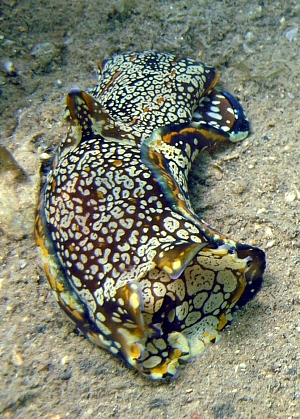
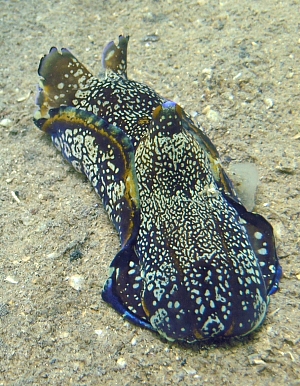

Dear Brent,
This is Philinopsis cyanea. Have a look at the Fact Sheet and associated messages for more information. It's a bit hard to know just how common this species is because it spends much of its time buried in the sand. As you have discovered, at times it can occur in quite large populations.
Best wishes,
Bill Rudman
Philinopsis cyanea? from Taiwan
May 17, 2006
From: Ching-Yao Chan
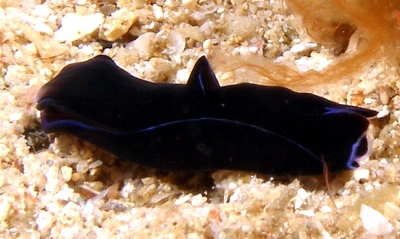
Dear Bill,
I think the photo is Philinopsis cyanea.
What do you think the correct species is?
Locality: Kenting, 6 metres, Taiwan, 05 May 2006. Length: 15 mm. Photographer: Ching-Yao Chan.
Best wishes,
C.Y.Chan
http://seaslug.myweb.hinet.net
logic.chan@msa.hinet.net
Chan, C.Y., 2006 (May 17) Philinopsis cyanea? from Taiwan. [Message in] Sea Slug Forum. Australian Museum, Sydney. Available from http://www.seaslugforum.net/find/16564
Dear Ching-Yao,
Yes this is P. cyanea, although I guess we should start calling it P. speciosa. It is not often we find a specimen with just blue lines, which makes it look a bit like Philinopsis gardineri, but in that species the head is much more bullet-shaped or tapered anteriorly.
Best wishes,
Bill Rudman
Philinopsis cyanea? from Victoria, Australia
March 24, 2006
From: Trevor McMurrich

Hi Bill,
I found the attached nudibranch and assumed it was Philinopsis cyanea but then I saw the Philinopsis depicta Fact Sheet which is more similarly coloured to the one I found than any P. cyanea I have seen on the forum.
Locality: Steeles Rock, Portarlington, 2 metres, Victoria, Australia, Port Phillip Bay, 18 March 2006, sand. Length: 25 mm. Photographer: Trevor McMurrich.
The different distributions of the two nudibranchs would infer it is P. cyanea. Can you please confirm identification?
Kind Regards
Trevor McMurrich
trevm@aanet.com.au
McMurrich, T.B., 2006 (Mar 24) Philinopsis cyanea? from Victoria, Australia. [Message in] Sea Slug Forum. Australian Museum, Sydney. Available from http://www.seaslugforum.net/find/16141Dear Trevor,
If you want to get really confused, have a look at the Fact Sheet from Philinopsis speciosa. My feeling is that P. cyanea, P. speciosa and P. depicta are one species. If you read my comments on the P. speciosa Fact Sheet you will see I don't think there are any obvious - or subtle - anatomical differences between the three species. I guess I am just a little hesitant to take the plunge and start calling them all P. depicta.
I almost forgot to mention that Port Phillip Bay is quite a way south for this species, which essentially has a tropical distribution. It is sometimes found down the east coast of Australia, in New South Wales, and probably gets into South Australia by way of the warm water currents down the West Australian coast, but Victoria doesn't usually receive these tropical adventurers.
Best wishes,
Bill Rudman
Re: Aggregation of Stylocheilus striatus in Indonesia [1]
January 23, 2006
From: Paul Whitehead
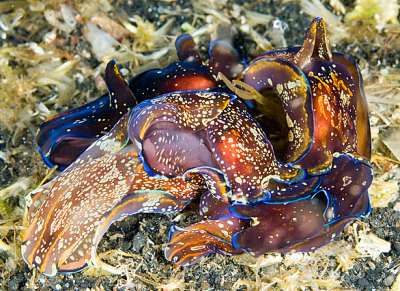

Concerning message #15378 on aggregation of Stylocheilus:
Dear Bill,
As promised attached are some photos of the other two aggregation species, which all aggregated with the same week and on the same site (Retal Larry, Lembeh Straits) following the September full moon.
Locality: Retak larry. Lembeh Straits, Indonesia. Depth: 3 meters. 15 September 2005. black sand beach with sparse cover. Photographer: Paul Whitehead
Immediately after the Stylocheilus aggregation the "white" species [see message #15630 ] aggregated over the site covering an area of about 20 meters by 20 meters and avaeraging about 10 animals per square meter. Whilst this aggregation was occurring, this third species aggregated covering the same area with about 10 animals per square meter again.
The whole cycle of the three aggregations lasted 1 week.
Paul
pw@whiteheadimages.com
Whitehead, Paul, 2006 (Jan 23) Re: Aggregation of Stylocheilus striatus in Indonesia [1]. [Message in] Sea Slug Forum. Australian Museum, Sydney. Available from http://www.seaslugforum.net/find/15629
Dear Paul,
This is Philinopsis cyanea, another species with a reputation for irregularly occurring in large aggregations. I recall seeing two such aggregations, one in Zanzibar in 1971, and another in mainland Tanzania a few years later - but they don't seem to be a regular occurrence - or perhaps there are too few people looking out for them. Aggregations like this are a good opportunity to see the range of colour variation in a species. I see that in your photo alongside there is a small specimen of the 'white swarmer' Gymnodoris ceylonica.
Philinopsis cyanea is another eater of opisthobranchs, usually cephalaspidean bubble shells, but it also feeds on Stylocheilus [see Mike Roberts message #14082]. As with Gymnodoris, I suspect the timing of the Philinopsis aggregation with the Stylocheilus aggregation is a coincidence rather than a consequence. That is not to say that the Philinopsis would not have taken advantage of so much food around.
Best wishes,
Bill Rudman
Philinopsis gardineri? from Reunion Island
December 13, 2005
From: Philibert Bidgrain
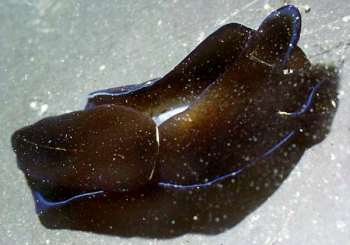
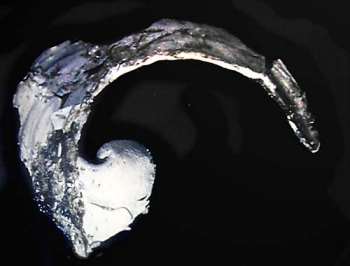
Dear Bill,
Reunion Island sea slugs.
In Reunion Island we have observed one specimen of this species. The specimen size is 32 mm and we have a photo of the fragile shell. Photographer: Maurice Jay.
I think it could be a specimen of Philinopsis gardineri, but you said that it was known only from the tropical western Pacific. What's your opinion?
Best Regards
Philibert Bidgrain
vieoceane.free.fr/runseaslug/indexslug.htm
vieoceane@free.fr
Bidgrain, P., 2005 (Dec 13) Philinopsis gardineri? from Reunion Island. [Message in] Sea Slug Forum. Australian Museum, Sydney. Available from http://www.seaslugforum.net/find/15435Dear Philibert,
I hope I am right in assuming the small spots over the body are small specks in the water rather than skin colour? Although this animal looks superficially like P. gardineri, I suspect it is a colour form of Philinopsis cyanea. The body has the more 'squarish' body shape found in that species than the elongate form of P. gardineri. Sometimes I can't be sure from a photo. There is of course no rule preventing P. gardineri turning up in the western Indian Ocean, it's just I don't think I can be sure from this photo.
Best wishes,
Bill Rudman
Re: Philinopsis cyanea mating in Reunion Island
November 25, 2005
From: Francis & Pirjo Pellet
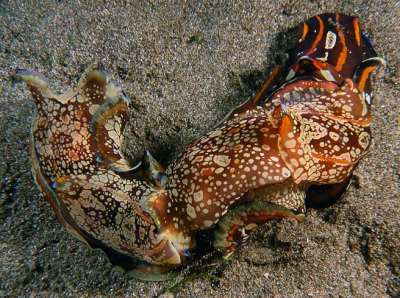
Dear Bill,
Following the message from Reunion Is, [message #15334], here is a record of Philinopsis cyanea from the Philippines (Anilao). They were quite big about 120 mm. We found them on a sandy bottom with some sea grass, and we observed many Bulla ampulla at the same place.
Locality: Anilao Pier, Luzon Island, Philippines. night dive. Depth: 5 m. Length: 120 mm. 24 February 2005. Sandy bottom. Photographer: Francis Pellet
Francis & Pirjo Pellet
pirjo.pellet@free.fr

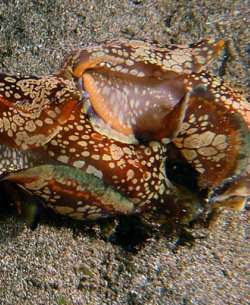
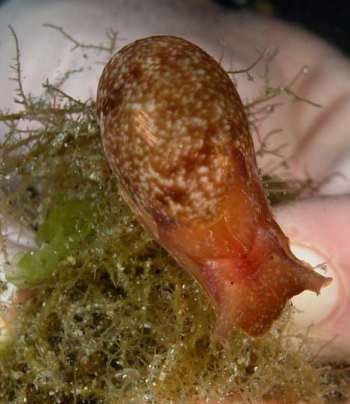
Dear Francis & Pirjo,
Thanks for these photos. They certainly illustrate both extremes of this species' colour range. I wouldn't be surprised if the plentiful Bulla, were being used by P. cyanea as a nice source of food
Best wishes,
Bill Rudman
Philinopsis cyanea spawning at Reunion Island
November 25, 2005
From: Philibert Bidgrain
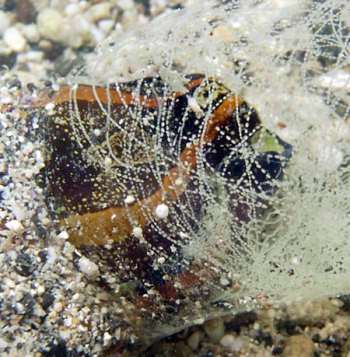
Dear Bill,
Reunion Island sea slugs.
Following my message [#15334] about mating, I have observed spawning at the same pool at 'Kélonia center' a Marine Turtle Center in Saint Leu.
Locality: pool at 'Kélonia center', Saint Leu , Reunion Island. Indian Ocean. Length: 130 mm. 18 November 2005. Photographer: Philibert Bidgrain
Three very big specimens (130 to 140 mm) of this species produced a lot of spawns for several days Each spawn consists in a long (length from 10 to 20 cm) jellylike tube on whose surface a long chain of white egg mass can be observed. The spawn is fixed to the substrate at one end. Each egg mass contains 20-30 eggs in the same capsule. The different capsules are connected by a thin filament. In the same period I also observed spawning of small specimens (35_ 40 mm) in Saint Gilles lagoon.
It's the first time that we observed such event in Reunion Island.
Best Regards
Philibert Bidgrain
http://vieoceane.free.fr/runseaslug/indexslug.htm
vieoceane@free.fr
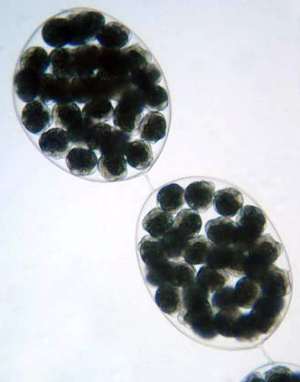
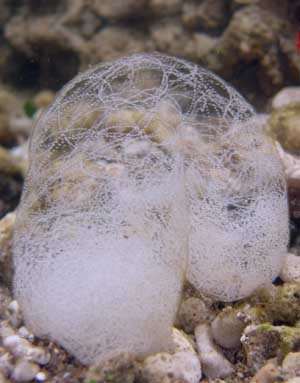
Dear Philibert,
It always fascinates me the way aglajids make their egg mass. Apparently they wrap the egg string around their body, coating it with mucus, and gradually pushing it off the head end, forming the characteristic sausage-shaped structure. The little string holding the egg capsules together is called the chalaza and is a characteristic feature of opisthobranch egg masses. The number of eggs in each capsule varies from species to species, some only have one egg per capsule, while others, such as some species of Aplysia can have 40 or 50.
Best wishes,
Bill Rudman
Two big Philinopsis cyanea mating in Reunion Island
November 23, 2005
From: Philibert Bidgrain

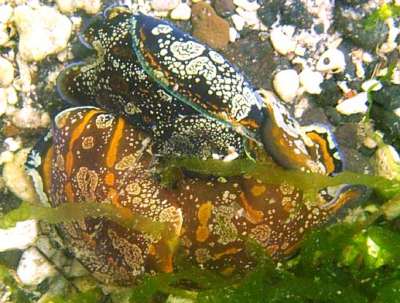
Dear Bill,
Reunion Island sea slugs.
The specimens of Philinopsis cynaea are about 130-140 mm length, its a record for our Island. This mating behaviour was observed in a pool at "Kelonia center" a Marine Turtle Center in Saint Leu.
Locality: in a pool at "Kelonia center" [Marine Turtle Center], Saint Leu. Reunion island, Indian ocean. Length: 130-140 mm. 18 November 2005. Photographer: Philibert Bidgrain
Best Regards
Philibert Bidgrain
http://vieoceane.free.fr/runseaslug/indexslug.htm
vieoceane@free.fr
Bidgrain, P., 2005 (Nov 23) Two big Philinopsis cyanea mating in Reunion Island. [Message in] Sea Slug Forum. Australian Museum, Sydney. Available from http://www.seaslugforum.net/find/15334Dear Philibert,
I found quite a few large animals one time in Zanzibar, but not quite so big as 13 cms. This size is certainly larger than I have heard of before
Best wishes,
Bill Rudman
More colour forms of Philinopsis cyanea
June 13, 2005
From: Dong Bum Koh
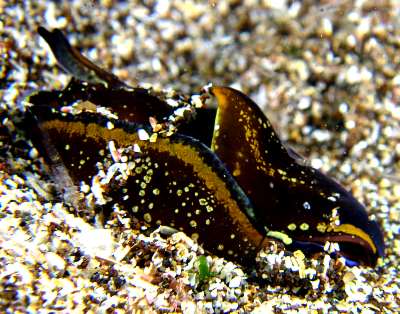
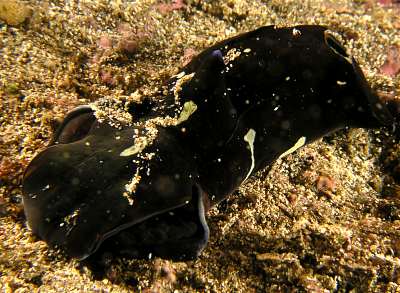
Dear Bill,
Concerning your comments [#13420] on my Philinopsis cyanea from Sth Korea. Could you confirm these 3 photos are of P.cyanea. I think that are color variation.
All Photos were taken during night diving at Jeju island.
Upper: Hwa Soon beach.4m depth taken by Byung Ro Youn. Jan.24 2005.
Middle: Sa Soo harbor.4m depth taken by Dong Bum Koh. Aug.15 2004.
Lower: Near Moon islet.20m depth taken by Dong Bum Koh. Sep.5 2000.
Dong Bum Koh
drkoh@seasee.co.kr
D. B. Koh, 2005 (Jun 13) More colour forms of Philinopsis cyanea. [Message in] Sea Slug Forum. Australian Museum, Sydney. Available from http://www.seaslugforum.net/find/13537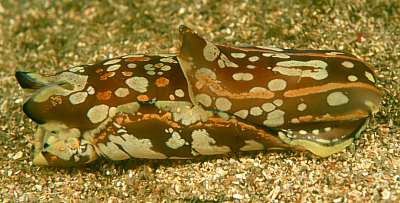
Dear Koh,
Yes these are all variations of P. cyanea. It is amazing how these could be part of the group from Tanzania I have used on the Fact Sheet to illustrate colour variation in the species. This species shows the same range of variation throughout its wide geographic range.
Best wishes,
Bill Rudman
Philinopsis cyanea ... eating?
April 28, 2005
From: Binyamin Koretz

Dear Bill,
We recently observed a Philinopsis cyanea (of the large red variety reported in message #13457 ) exhibiting the behaviour captured in the accompanying photos.
After the animal had disappeared into the sand, head first, out of curiosity, I gently touched the sand where I thought he would be. What appears to be a covering of mucus-sealed sand was then ripped open, revealing the slug [Fig 2 - lower left].
In photos 3a through 3d, the front of the slug starts to reappear, first the top of the headshield, and then we see the head bulging forward. I again touched the sand covering the back of the slug, and it felt quite flat - flatter than it should have. This all took about 5 minutes. Unfortunately, we were at the end of a very long dive and I was low on air, so we couldn't stay any longer.
Locality: Eilat, Village Beach, Israel, Red Sea (Gulf of Eilat). Depth: 3 m. Length: 8 cm? 18 April 2005. sand and rubble slope. Photographer: Binyamin and Shulamit Koretz
After reading on your fact sheet about the eversible buccal bulb and the way this species swallows its prey whole, we thought that it was possible that that's what we were witnessing. What do you think?
Best regards,
Binyamin
binyamin@koretz.net
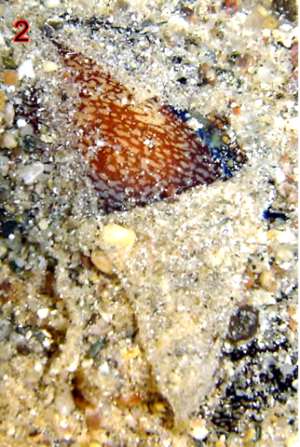

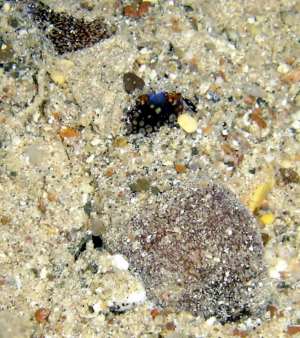
Dear Binyamin,
I've looked at your photos carefully, and also the others you sent but I haven't included and I am pretty sure that wjhat you saw is an animal burrowing through the sand. They ahve huge mucus glands around the head which produce a cylinder [or tunnel] of mucus through which they crawl when 'underground' so they don't clog up their gills. What you tore, in your Photo 2 is that mucus skin that the tunnel is made of. In the photo alongside, the blue spot you can see in the middle of the photo is the spot on the posterior tip [or horn] of the headshield, so the bit at the bottom of the photo is the head.
Like all burrowers, catching them feeding is almost impossible. I have watched them engulf various bubble-shells in aquaria, and they do eat bubble-shells which normally live on the surface as well as ones that burrow, but it's difficult. I spent 3 years as a student trying to catch species of Philinopsis and Philine in the act of feeding - a quite soul-destroying activity. Most of our information on their feeding comes from either examination of the stomach contents of preserved animals or from watching captured animals regurgitating the unbroken shells of their prey
Best wishes,
Bill Rudman
Philinopsis cyanea from South Korea
April 14, 2005
From: Dong Bum Koh
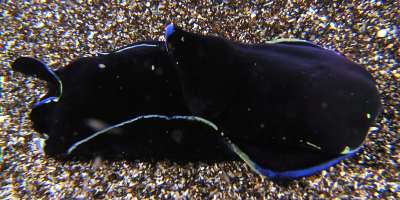
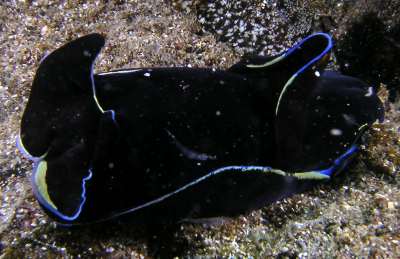
Dear Bill,
I would like introduce Philinopsis gardineri (Eliot, 1903) for your Forum.
Please give me your comments on this animal? I really don't know how to thank you for all your comments that are very helpful for me.
Locality: Hwa Soon, South Korea. Depth: 4 m. Length: about 90 mm. 22 January 2005. Sandy bottom with Rock Wall. Photographer: Byung Ro Youn.
Best regards,
Dong Bum Koh
drkoh@seasee.co.kr
D. B. Koh, 2005 (Apr 14) Philinopsis cyanea from South Korea . [Message in] Sea Slug Forum. Australian Museum, Sydney. Available from http://www.seaslugforum.net/find/13420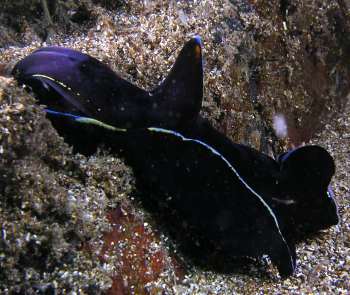
Dear Koh,
By coincidence, Binyamin Koretz has sent a message about this species from Israel [#13457]. It is a colour form of Philinopsis cyanea, and at 90 mm is quite a large specimen. Your photos show the posterior tip of the head shield forming an erect funnel, and one of your photos shows the posterior end of the visceral hump or 'posterior shield' expanded. This colour form certainly has similarities to P. gardineri but that species only has blue in its colour pattern, never yellow. Also P. gardineri is more elongate and the posterior tip of the head shield is rounded, and unable to fold up into a funnel like P. cyanea.
Best wishes,
Bill Rudman
Philinopsis depicta? from the Red Sea
April 14, 2005
From: Binyamin Koretz
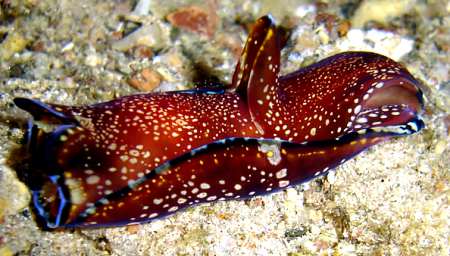
Hi Bill,
Philinopsis cyanea appears in Eilat in the spring (roughly March-June) and we've never seen one bigger than 1.5 cm. This month (March) alone, we've seen 3 different specimens - all of them 1-1.5 cm in length and brown to black. Now we've encountered this robust individual, which we measured at about 8 cm when fully extended. Not only is the size out of proportion in light of the seasonality and the fact of its co-generationists being one-sixth the size, but also the reddish base color and the relative height of the top of the headshield don't fit the P. cyanea mold. In fact, it's remarkably similar to the 1998 Italian photo by Gianni Neto on your P. depicta Fact sheet, down to the irridescent blue tone in the red base color.
Locality: Eilat, Village Beach. Israel, Red Sea (Gulf of Eilat). Depth: 4 m. Length: ca. 8 cm. 26 March 2005. rubble slope, night. Photographer: Binyamin and Shulamit Koretz.Playing amateur scientist, we came up with 3 possible explanation
-
(our favorite) This is P. depicta, and it can now be considered a reverse Lessepsian migrant.
-
This is P. cyanea, but then, as you suggested elsewhere in the Forum, P. depicta and P. cyanea would have to be the same species.
-
(least likely) There are 2 different species with overlapping ranges, but one is small and brownish-black, and the other is large and tends to reddish.
What do you think?
Best regards,
Binyamin
binyamin@koretz.net
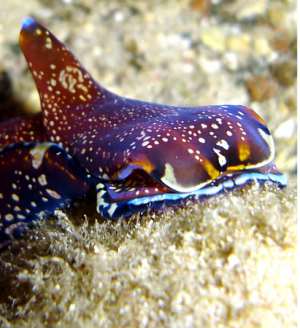
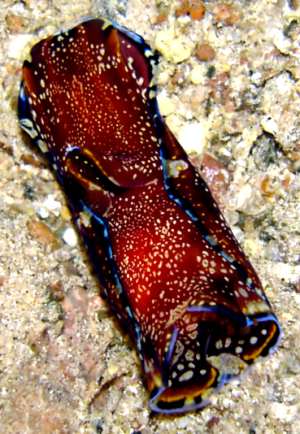
Dear Binyamin,
You raise a number of interesting points, including whether there are any examples of Mediterranean to Red Sea migration.
Concerning the identity of your animal. As you mention, I have difficulty in separating Philinopsis depicta and P. cyanea, apart from their geographic distribution. Their anatomy appears to be the same and they have the same very variable colour range. Concerning the 'the relative height of the top of the headshield' of your individual, and its large size, have a look at the animals from Zanzibar and Dar es Salaam I have on the P. cyanea Fact Sheet, showing an equally large 'horn' on the posterior head shield and animals growing to 7 cm in length.
Size is quite an interesting characteristic in aglajids. I have found species such as Chelidonura inornata and C. fulvipunctata in huge numbers, mating and laying fertile eggs in Sydney, but growing to no more than 15 mm long, while in tropical waters they grow to twice or three times that length. I am not sure if food availability or environmental temperature affects their growth rate. Age certainly affects their size. Most cephalaspideans that have been studied, live for no more than a year, but a few individuals in a population appear to 'over winter' and so can live for at least 2 years. As they continue to grow, they can become relative giants. I suspect the large animal you have found is one of these.
At this stage I would say it is P. cyanea. The bluish tinge you note is found in most aglajids - certainly in those with darker colours and is a 'structural' colour caused by the way light is reflected and refracted off the constantly beating microscopic cilia that cover the skin of these animals.
Best wishes,
Bill Rudman
Philinopsis cyanea? from Indonesia
January 13, 2004
From: Francis & Pirjo Pellet
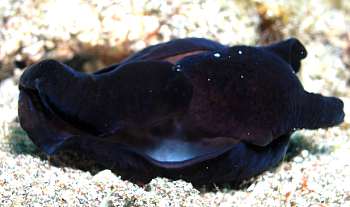
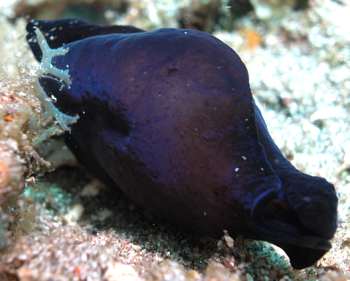
Dear Bill,
We found this headshield slug on a sandy bottom at the depth of 8 m. We are not sure of it's ID, we haven't found anything that looks alike. We saw in your message about Philinopsis cyanea that the colour varies from plain black to black with blue. This one is totally black with some blue nuances.
Data
Dive site: Pante Parige, Lembeh Straits, Indonesia
length: 4 cm
depth: 8 m
28 September 2003
Best regards
Francis & Pirjo
f.pellet@medsyn.fr
Pellet, F. & Pellet, P., 2004 (Jan 13) Philinopsis cyanea? from Indonesia. [Message in] Sea Slug Forum. Australian Museum, Sydney. Available from http://www.seaslugforum.net/find/11869Dear Francis & Pirjo,
Yes I am pretty sure this is Philinopsis cyanea . From the very swollen look of the animal in your second photo I would suspect it is trying to digest a fairly large bubble-shell. They swallow live bubble-shells whole, regurgitating the empty shells after they have digested the animal
Best wishes
Bill Rudman
Philinopsis cyanea from Port Stephens
May 13, 2003
From: Leanne&David Atkinson
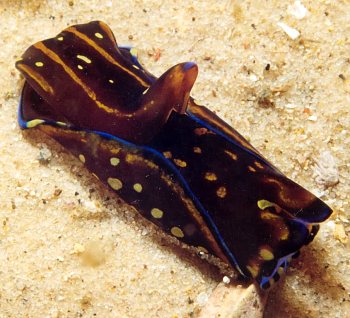
Dear Bill,
Here is a photo which we think is Philinopsis cyanea. It was taken at Fly Point, Port Stephens,, New South Wales, Australia during daytime on the high tide in December 2001.
Regards,
Leanne & David Atkinson
atk@hunterlink.net.au
Atkinson, L. & D., 2003 (May 13) Philinopsis cyanea from Port Stephens. [Message in] Sea Slug Forum. Australian Museum, Sydney. Available from http://www.seaslugforum.net/find/9882Dear Leanne & David
Yes this is P. cyanea. Although you don't mention a size, I suspect this is a juvenile or half-grown animal, because in smaller animals the crest on the posterior edge of the head shield is usually relatively large for the size of the animal. This animal shows one of the main color differences between this species and P. taronga. In P. cyanea there are either two orange/yellow lines on the head - or traces of them, while in P. taronga there is a single median line - traces of it.
Best wishes,
Bill Rudman
Philinopsis cyanea & possible egg mass
May 9, 2003
From: Leanne Atkinson
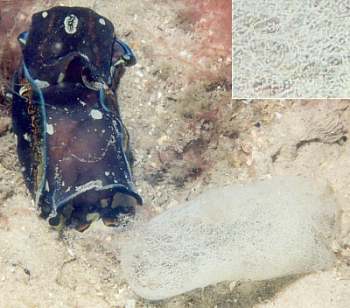
Dear Bill,
Over the summer of 2001 and 2002 we had quite a few Philinopsis sightings at Fly Point, Port Stephens, NSW. Here is the first, which didn't look healthy, next to what I thought was some eggs. David disagreed with me about them being eggs. We found it at about 8m in a very sandy area. Do i>Philinopsis lay eggs and then die, like some short lived creatures? I've included a close-up of what I was calling eggs. Can you identify which Philinopsis it is? We've seen what we think are P. cyanea, P. depicta and P. lineolata in the same area around the same time. We're sending those in separate messages.
Regards,
Leanne Atkinson
atk@hunterlink.net.au

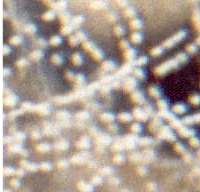
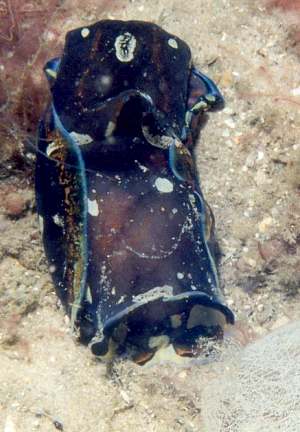
Dear Leanne,
Although I can't be ceratin this animal laid the eggs, they are almost certainly the egg mass of a Philinopsis. This animal is a colour form of P. cyanea. I will post your other aglajid messages in a few days when I get some loal photod organised to accompany them. The animal you think is P. depicta is P. taronga. I wanted to post this message today to accompany Johny's photo of the egg mass of Chelidonura amoena.
Best wishes,
Bill Rudman
Philinopsis cyanea from Lembeh Strait
February 6, 2003
From: Mary Jane Adams

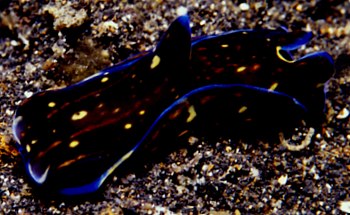
Hi Bill,
Here are some images of Philinopsis cyanea from Lembeh Strait, Sulawesi Island, Indonesia. The upper image is from Hairball, a silty, volcanic sand slope. It was a fat, 7 cm long slug.
The middle and lower images are from a nearby, similar divesite, Hairball Two. The middle one was in the 6-7 cm range and the lower one was about 2cm. long. They were all crawling around at about 5 - 8 meters where the sand is soft and loose. These guys can really crawl fast! I guess that is expected of slugs that hunting mobile prey. I wonder which of their cousins they have been eating. Nov. 20 - 25, 2002.
Best regards,
Mary Jane
divepng@yahoo.com
Adams, MJ., 2003 (Feb 6) Philinopsis cyanea from Lembeh Strait. [Message in] Sea Slug Forum. Australian Museum, Sydney. Available from http://www.seaslugforum.net/find/8713Thanks Mary Jane,
This species seems to be prefer 'bubble shells' such as Atys, Haminoea, and Bulla. They will often regurgitate the empty shells if you collect them and keep them in an aquarium overnight.
Best wishes,
Bill Rudman
Philinopsis cyanea from Lizard Is
February 3, 2003
From: Nils Anthes
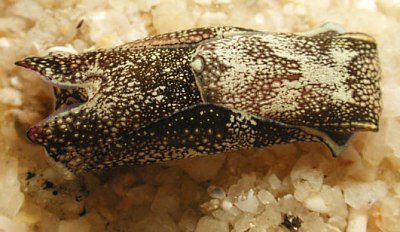
Dear Bill,
Philinopsis cyanea appears to be common on sandy beaches at Lizard Island [north Queensland, Australia] in all possible colour variations. I include 2 pictures [lower photos] that show the colour range.
We also found 2 specimens [upper right photo]at the same places, that basically lack the typical P. cyanea pattern, but are covered with small whitish spots all over. The margins of the parapods have inconspicuous orange and blue lines. They resemble in colouration P. troubridgensis. What is the difference between these two species?
Kind regards,
Nils
anthes@uni-muenster.de
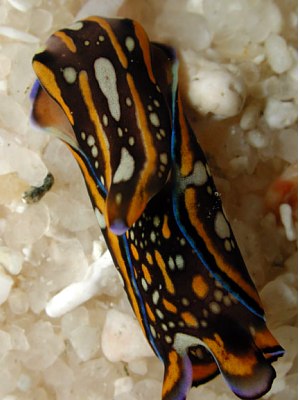
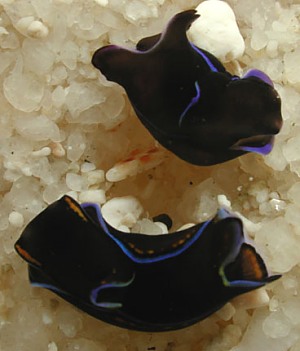
Dear Nils,
I'm pretty sure the spotted animal in the top photo is part of the colour variation within P. cyanea. If you look at some of the photos in other messages you will see intermediates between your colour pattern and more 'typical' specimens. I illustrated this wide colour variation in a population I found in Zanzibar [Rudman, 1972]. This spotted colour pattern does look quite like 'typical' P. troubridgensis, but that species also seems to be quite variable in colour. Unfortunately we don't know much about P. troubridgensis because most records are of dead or dying specimens washed up on beaches in South Australia. Its one claim to fame is its size. Growing to at least 70mm long, it is probably the largest
• Rudman, W.B. (1972) A comparative study of the genus Philinopsis Pease, 1860. (Aglajidae, Opisthobranchia). Pacific Science, 26(4): 381-99, 15 figs, 1 plate.
Best wishes,
Bill Rudman
Philinopsis cyanea from Lord Howe Island
January 10, 2003
From: W.B. Rudman
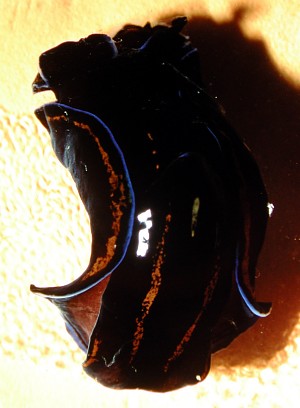
Here is a photo record from Ian Hutton of Philinopsis cyanea from Lord Howe Island.
Location: Neds Beach.
Bill Rudman
Rudman, W.B., 2003 (Jan 10) Philinopsis cyanea from Lord Howe Island. [Message in] Sea Slug Forum. Australian Museum, Sydney. Available from http://www.seaslugforum.net/find/8806Philinopsis cyanea from Lord Howe Is.
December 6, 2002
From: Ian Hutton

Hi Bill,
This looks like Chelidonura varians but brown and 5cm long. Sandy intertidal pool in lagoon Lord Howe Is.,[Coral Sea] November 2002. It is similar in structure to Chelidonura varians except larger (5cm long) and brown instead of black and blue. On sandy bottom. It is rare here as I have spent 20 years fossicking in rock pools and first one seen.
Ian Hutton
alfa@tpgi.com.au
Hutton, I., 2002 (Dec 6) Philinopsis cyanea from Lord Howe Is.. [Message in] Sea Slug Forum. Australian Museum, Sydney. Available from http://www.seaslugforum.net/find/8591Dear Ian,
This is Philinopsis cyanea. It is an aglajid, like species of Chelidonura but doesn't have their long characteristic 'tails'. It feeds on shelled cephalaspideans (bubble shells)
Best wishes,
Bill Rudman
Philinopsis mating from Korea
June 17, 2002
From: Dong Bum, Koh
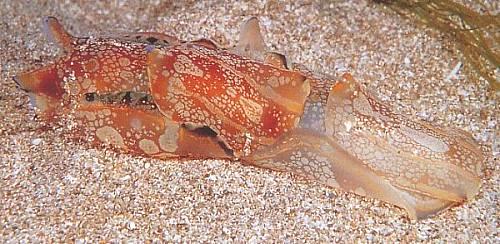
Dear Bill,
I suspected that this was Aglaja depicta (Renier, 1807) but when I look closely I realised that it was not one but two animals. I presume they are mating. Can you tell me if this is really two, and if this is the mating position.
Date: 2001.March.
Location: Seogwipo, Cheju Island, Korea.
Depth: 20m.
Photo by: Dong Bum, Koh
With best Regards.
Dong Bum, Koh
drkoh@seasee.co.kr
Koh, D.M., 2002 (Jun 17) Philinopsis mating from Korea. [Message in] Sea Slug Forum. Australian Museum, Sydney. Available from http://www.seaslugforum.net/find/7231Dear Dr Koh,
Thanks for this interesting photo. Yes these are two aglajids mating. The penial sac is on the anterior right corner of the head, the penis only extending out of the sac during mating. The common male & female genital opening is at the back of the body on the right side, on the floor of the reduced mantle cavity. Sperm reaches the penis in a ciliated groove running along the right side of the body from the common genital opening. As in the Sea Hares, aglajids mate 'head to tail' the anterior one acting as female and the posterior one as male. As with Sea Hares, a number of animals can mate simultaneously by forming a mating chain, in which the animals in the middle of the chain act as both male and female. Although I have no photos, I have observed 10 or more animals of the little black aglajid from New Zealand, Melanochlamys cylndrica in such a chain.
Now to the identity of your animal. The colour of the two animals in your photo show just how variable some of these species can be. It does look quite like A. depicta but it is unlikely that that mediterranean species would be found in the tropical NW Pacific. I am pretty sure your animal is a colour form of the widespread Indo-West Pacific species Philinopsis cyanea. It ranges in colour from animals with a dark blue black background colour to those like yours woth a translucent body with a brownish reticulate pattern. What all these colour forms have in common is traces of two or three large whitish patches down the midline of the headshield and two pairs of orange-yellow longitudinal lines on each side of the headshield. Another species, P.gigliolii (Tapparone-Canefri, 1874) was described from Japan from preserved specimens. The colour was reported to be a buff-white reticulated with brown or ash-coloured lines, and the head shield was said to have a median longitudinal pale line. In Okutani, 2000 [Marine Mollusks in Japan: Pl.374 fig.2] there is a photo which fits that description. It appears to be distinct from P. cyanea.
Best wishes,
Bill Rudman
Philinopsis cyanea from Sulawesi
May 4, 2002
From: Mary Jane Adams
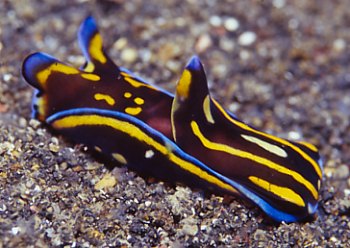
Hi Bill,
I found this little gem crawling over a sand slope in Lembeh Strait, Sulawesi, Indonesia. It was 16 mm long. Divesite: Hairball.
April 11, 2002
Best regards,
Mary Jane
divepng@yahoo.com
Adams, M J., 2002 (May 4) Philinopsis cyanea from Sulawesi. [Message in] Sea Slug Forum. Australian Museum, Sydney. Available from http://www.seaslugforum.net/find/6881Thanks Mary Jane,
It's interesting how consistent the colour pattern on the headshield is - two pairs of yellow lines and a pair of elongate cream patches in the midline are present in most of the photos, although sometimes well hidden.
Bill Rudman
Philinopsis cyanea mating
May 4, 2001
From: Julie Marshall

Dear Bill,
These two Philinopsis cyanea were some of a number of this species I found at Heron Island [Great Barrier Reef, Queensland, Australia] in November 1999. All were between 20 and 25 mm in size and varied enormously in colour and patterns from black with only very faint markings, to pale animals like the ones in this picture. They began mating soon after I brought them into the laboratory and remained entwined for about 30 minutes.
Best wishes,
Julie Marshall
j.marshall@latrobe.edu.au
Marshall, J., 2001 (May 4) Philinopsis cyanea mating. [Message in] Sea Slug Forum. Australian Museum, Sydney. Available from http://www.seaslugforum.net/find/4274Dear Julie,
Thanks for the great photo. P. cyanea is certainly very variable in colour. For those unfamiliar with aglajid mating behaviour, they are anatomically a bit different from nudibranchs. They have the penis at the front of the body, just to the right of the mouth, and the female genital opening is at the back of the body on the right hand side. In mating, if there are only two animals one usually acts as the male and the other as the female. In this photo, the one on the right is the acting male. However if there are three or more together they can form mating chains, a bit like sea hares, with one in the front acting only as the female and one at the bac of the chain acting only as a male, while the ones between these two act as male and female simultaneously.
Best wishes,
Bill Rudman
Philinopsis cyanea from New South Wales
April 3, 2001
From: Erik Schloegl
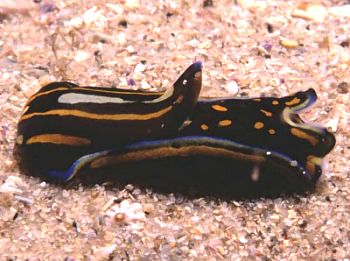
Dear Bill,
Here's a photo of Philinopsis cyanea taken at Cabbage Tree Island outside Port Stephens, New South Wales, on 4 April, 1999. The animal was crawling on sandy bottom at a depth of 12m.
Best wishes,
Erik
Erik.Schlogl@uts.edu.au
Schloegl, E., 2001 (Apr 3) Philinopsis cyanea from New South Wales. [Message in] Sea Slug Forum. Australian Museum, Sydney. Available from http://www.seaslugforum.net/find/4097Dear Erik,
This is another tropical visitor which sometimes makes it down into New South Wales.
Best wishes,
Bill Rudman
Philinopsis from Mauritius
July 27, 1998
From: Owen Griffiths
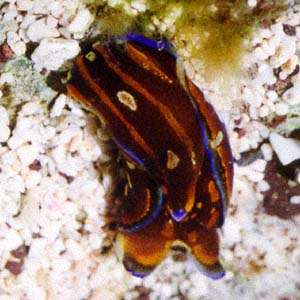
Dear Bill,
Could you tell me anything about this slug I found crawling across the reef platform near my home in Mauritius.
Thanks
Owen Griffiths
Mauritius.
Olgmas@bow.intnet.mu
Griffiths, O., 1998 (Jul 27) Philinopsis from Mauritius. [Message in] Sea Slug Forum. Australian Museum, Sydney. Available from http://www.seaslugforum.net/find/155Dear Owen,
Your animal is Philinopsis cyanea, a quite variable species found throughout the tropical Indo-West Pacific. Juvenile animals, like the one in your picture are often more colourful than adults. ... Bill Rudman.
